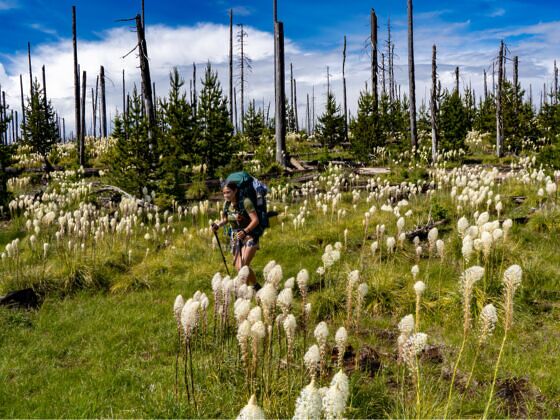1. Death Valley
Death Valley is a landscape of sublime desolation. While it’s difficult to take extended hiking trips here — you must bring in all of your own water — a number of sights can be visited by 4-wheel drive.
Death Valley is home to stunning natural phenomena. Take a day trip across the Badwater Basin salt flat, the lowest point in North America, and visit Furnace Creek, which sees the hottest recorded temperatures in the Western Hemisphere. Explore Racetrack Playa and its mysterious sailing stones, the Mesquite Sand Dunes, and the Devil’s Golf Course with its enormous fingerlike salt crystals. January is a great time to visit to avoid the valley’s staggering summertime heat.
2. The Coastal Trail and the Lost Coast
Highway 1 veers inland away from the dramatic coastal cliffs of the King Range, leaving a stretch of wilderness between Mendocino and Eureka in Northern California. Trekkers on the Coastal Trail will encounter seals and sea lions, gigantic waves, and virgin redwood stands in the hollows of Sinkyone Wilderness State Park.
Bring your rain gear. The Lost Coast is the wettest region of the state, and some parts get up to 100 inches of annual rainfall.
3. Garnet Lake
The arduous trek to Garnet Lake in the Ansel Adams Wilderness is a photographer’s dream. Environmentalist John Muir considered this alpine lake framed by snowy mountains his church.
Because of its location in the high Sierras, the trailhead that begins at Devil’s Postpile is only open from June to early December, depending on the snowfall. The area is known for its many bears, so be sure to bring bear canisters to protect your food or face a long, hungry walk back to civilization. Ambitious climbers might consider ascents of Mount Ritter and Banner Peak.
4. Yosemite and Hetch Hetchy
Of the 750 trail miles in Yosemite, the loop through Beehive Meadows to Lake Vernon from the Hetch Hetchy Valley might be the most rewarding. Contemplate the park’s famous granite domes and swim the crystal waters of Lake Vernon.
Late May to early June is the best season to visit, when indigenous wildflowers are in full bloom and snowmelt is still cascading down Rancheria Falls into the reservoir.
5. Point Reyes National Seashore
Just an hour north of San Francisco, Point Reyes provides 150 miles of excellent hiking trails and camping opportunities within easy reach of the city. A trail near the visitors center runs along the San Andreas Fault, where the power of the 1906 earthquake that leveled San Francisco is illustrated by a 15-foot separation in an old wooden fence.
Because Point Reyes juts out several miles into the Pacific, its quiet beaches are perfect for whale watching in April and November.
6. San Francisco
Let’s move on to some urban trekking. San Francisco is a walker’s paradise, where you can traverse the city from the bayside to the ocean and explore dozens of neighborhoods and hilltop parks along the way. Start in the Mission and head towards Golden Gate Park, or stick farther north to see Lombard Street and the Marina District and wind through the Presidio.
Even on a sunny day you’ll notice San Franciscans carrying their jackets. Do the same — temperatures plummet under the rolling banks of fog.
7. Los Angeles
To live in Los Angeles without a car is akin to living anywhere else without legs. Angelenos will think you’re crazy when you mention your urban trek from downtown to the Pacific. However, the 20-mile jaunt passes many of LA’s best attractions, and amazingly, there are sidewalks.
Start at Union Station and take Sunset Boulevard northwest into the hipster village of Silver Lake. Continue on Sunset until you reach Hollywood Boulevard and its grimy tattoo parlors. Take pictures with the buskers outside the Chinese Theater. Go south back to Sunset and head west for Sunset Strip’s nightclubs and rock venues, where West Coast bands dream of hitting the big time. Skirt ritzy Beverly Hills and take Venice Boulevard all the way to the boardwalk at Venice Beach, where you’ll be treated to some of LA’s finest characters.
8. Mount Shasta
Like her Cascade Range cousins farther north, glacier-peaked Mount Shasta is visible from 100 miles away. It’s popular with mountain climbers in the summer and backcountry skiers in the winter.
The popular Avalanche Gulch Trail starts at the tree line and rises 6,300 feet over rocky moraines and snowfields to the summit.

